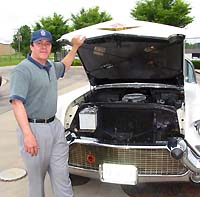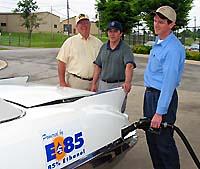UK College of Ag Second Stop in Coast-to-Coast Ethanol Journey
UK College of Ag Second Stop in Coast-to-Coast Ethanol Journey


 Virginian Chris Lapp is on a coast-to-coast journey to help Americans see the viability of alternative fuels, and the University of Kentucky College of Agriculture was his second pit stop. He left the Washington, D.C., area June 1, setting out for San Diego, Calif., in a 1957 Cadillac Eldorado Biarritz convertible running primarily on 85 percent ethanol fuel.
Virginian Chris Lapp is on a coast-to-coast journey to help Americans see the viability of alternative fuels, and the University of Kentucky College of Agriculture was his second pit stop. He left the Washington, D.C., area June 1, setting out for San Diego, Calif., in a 1957 Cadillac Eldorado Biarritz convertible running primarily on 85 percent ethanol fuel.
The biggest challenge for Lapp is finding ethanol fueling stations across the country, but he wanted to show people it can be done while becoming the first person to drive coast-to-coast on 85 percent ethanol fuel. There are only two ethanol fueling stations in Kentucky, and one happens to be at UK College of Agriculture Motor Pool.
“He called me a couple weeks ago when he was organizing his trip,” said Bill Peterson, director of management operations for the UK College of Agriculture. “He found our name as an ethanol fueling site. We don’t usually sell cash fuel since our pumps are primarily for our motor pool vehicles, but for this I told him we would.”
The majority of the college’s motor pool vehicles are flex-fuel, meaning they can run on ethanol or regular gasoline.
Lapp, a nuclear and environmental consultant, rebuilt the Cadillac’s engine to run on ethanol just two weeks ago. He added an extra fuel tank, making the capacity about 40 gallons.
“The biggest challenge is going to be finding fuel,” Lapp said. “From here I will go to Louisville and top off the tank and then my next stop is Kansas. From there I go to Colorado Springs and on to Albuquerque before heading to Tucson. I’m going to the American Nuclear Society conference in San Diego.”
While at the conference Lapp will speak on a panel and dedicate the session to his father Ralph Lapp, a Manhattan Project physicist who, with Edward Teller, built the first hydrogen bomb in 1949. Lapp said he wants to show the nuclear scientists that ethanol is a viable fuel alternative.
“I’m a pro-person, I’m for trying everything,” he said. “I believe that you don’t get anywhere if you don’t do anything, so I want to show them it can be done.”
Lapp chose the classic automobile for his journey because he wanted to “be different” and show people that if he could make it across the country on ethanol in that vehicle, anyone could do it with the flex-fuel cars available today.
The average price for a gallon of fuel in 1957 was about 55 cents per gallon, according to the U.S. Department of Energy. Today the average is closer to $2.12 per gallon. In a time where renewable fuels are becoming a major focus, Lapp’s journey could be important to the way Americans view ethanol and other alternative fuel options. Recently the U.S. Senate passed legislation that could require refineries to use renewable components in gasoline by 2012. If signed into law, the bill would increase ethanol use in the United States to 8 billion gallons per year – double the amount used now.
American Coalition for Ethanol officials said that the need for crude oil could drop by 2 billion barrels per year by increasing the amount of ethanol in gasoline.
The UK College of Agriculture installed a fully-automated, 24-hour refueling station for state-owned flex-fuel cars that run on 85 percent ethanol in 2000. Peterson said the tank holds 10,000 gallons of E-85 fuel. E-85 is a blend of 85 percent ethanol and 15 percent unleaded gasoline.
While ethanol can be produced using a variety of agricultural feedstocks, the vast majority of domestic ethanol is produced from corn. EPA studies have shown that high blends of ethanol reduce harmful carbon monoxide emission levels by more than 25 percent.
Lapp has a Global Positioning Device (GPS) in his vehicle, and a friend back home in Virginia will soon be tracking his progress on the Ethanol Across America Web site.
“The stations are out there,” said Lapp about finding ethanol fueling stops on his journey. “I just want people to see that there are alternatives to get us to the future. I want to show people that ethanol could be a part of the equation in solving the fuel issue. It’s a bridge between natural gas and petroleum.”
